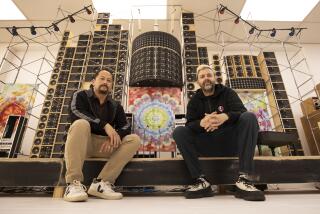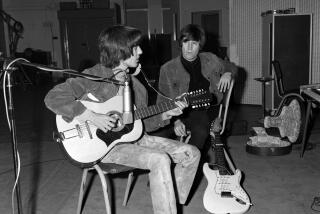Orange County Guitar Maker Reprises Famed Lennon Model
SANTA ANA — Back in 1960, when John Lennon was just another guy strumming a guitar in a rock ‘n’ roll band--this one an obscure outfit called the Beatles--he wandered into a music store in the German city of Hamburg, where the group was playing, in search of a certain guitar.
“Give m any Rickenbacker in the shop,” he is supposed to have said.
There weren’t any in stock. But the manager must have liked the dark, brooding rocker because he returned from a U.S. trade show shortly afterward with a Rickenbacker in his luggage. It was a display guitar and he’d bought it right out of the manufacturer’s booth.
Nobody--least of all Lennon--could have known it then, but he’d just sent the fortunes of a small Orange County guitar manufacturer soaring. It would take a few years, but when the Beatles became the most famous pop group in the world they would bring Rickenbacker with them.
Sales of the guitars--which were made in a prosaic neighborhood in Santa Ana--went through the roof after fans saw the Beatles playing them in magazines, on television and in their movies.
Now Rickenbacker is preparing to capitalize on Lennon again, this time with a limited edition of 2,000 guitars like the ones he played. The company will roll the Lennon edition out at the annual National Assn. of Music Merchants trade show that begins today at the Anaheim Convention Center.
Rickenbackers have never been cheap, even before the Beatles’ heyday. The new guitars will sell for about $1,800 with case. But Rickenbacker expects them to sell well to certain groups of guitar fanciers: “Collectors, people with an historical interest, and a lot of Japanese,” said John Hall, the company’s president.
The Japanese are big on collecting rock ‘n’ roll instruments and have pushed prices for vintage instruments and equipment like amplifiers way up, according to collectors.
Rickenbacker International Corp. is a traditional--some say “stodgy”--company that still makes electric guitars much like the one Lennon bought 30 years ago. Part of the reason for that is tradition, and part of it--the company admits--is simply its inability to get people to buy anything but the distinctive traditional guitars.
As a result, the company has stayed small with annual sales of less than $10 million. Still the quality of its instruments, even Rickenbacker’s critics concede, has been consistently good.
Orders this year are way up, says Hall, though he won’t say how much. The guitar industry is notoriously close-mouthed and for the most part privately held. Rickenbacker falls into both categories.
But the company hasn’t always been flush. In fact it’s gone through some thin times since hitting it big in the ‘60s.
Back then, influenced by the Beatles, other top rockers rushed out to buy the guitars, including Pete Townshend of the Who and Roger McGuinn of the Byrds, who had seen his first one in the Beatles’ movie “A Hard Day’s Night.”
Lennon, in fact, had bought one because one of his idols, jazz musician Toots Thielemans, played a Rickenbacker in pianist George Shearing’s group.
By the mid-1960s the guitars’ distinctively high, jangly tones were all over the rock records of the time: The Beatles’ “Ticket to Ride,” The Birds’ “Mr. Tambourine Man,” the Who’s “Can’t Explain.”
Rickenbackers even look different. With their unusual, rounded shape they look nothing like rock’s two most ubiquitous guitars, for instance: Gibson’s angular Les Paul and Fender’s space-age-looking Stratocaster.
But the Beatles broke up, rock music got grittier and the new superstars of guitar--Eric Clapton, Jimi Hendrix, Jimmy Page--favored instruments with a rougher, tougher sound. Rickenbacker’s guitar sales languished through the 1970s--although their basses did well--and sales haven’t really come back until recently.
Now people who were kids in the 1960s and are now nostalgic, well-heeled adults are buying Rickenbackers. Then there are the younger professional musicians trying to evoke a ‘60s sound on their records, such as Tom Petty and the all-women group the Bangles.
All that new demand brings its own problems.
With a nine-month backlog of orders, there’s a temptation to rush units out the factory door, which Hall says his company is resisting.
“If I could make five times as many guitars, I could probably sell them all,” Hall said. “But I can’t do it. At least, I can’t do it with the same quality.”
Rickenbacker still makes the 1959 and 1963 models Lennon played--fans like the company’s loyalty to tradition--but the new guitars will be subtly different, mostly around the top of the guitar where the tuning pegs are. That’s because Lennon modified his guitars and never really played stock models anyway. His guitars were specially made by Rickenbacker, which was run by Hall’s father then.
The new guitars will, however, have the same innards; there will be no fancy new electronics in these guitars.
They’ll come in three models, one a three-quarter-size guitar like the one Lennon actually played. “He played the smaller guitar because he had short, thick fingers,” said Hall, who met the Beatles at his father’s factory while a teen-ager. “He was only about 5 feet, 8 inches tall. When I was 14 and 15 I was bigger than he was.”
Another model comes full-size--”for the people who’ll really play them,” said Hall--and then there’s a 12-string edition.
Lennon, of course, died in New York City in 1980, shot by a demented fan. The estate gets a royalty payment from the sale of the guitars.
Yoko Ono, Lennon’s wife, had the first limited-edition guitar rushed to psychedelic artist Peter Max, who painted it. She then gave it to her teen-aged son Sean as a birthday gift Oct. 9.
It was Lennon’s birthday too.
More to Read
The biggest entertainment stories
Get our big stories about Hollywood, film, television, music, arts, culture and more right in your inbox as soon as they publish.
You may occasionally receive promotional content from the Los Angeles Times.









